This week I examine the perforations that were used on the stamps of this issue. There were six perforations employed on the stamps of this issue as it relates to measurement, and more when you consider the way in which the sheets themselves were perforated. The five perforations are:
- Comb 12 x 12.5, which was used on all the low value stamps printed by CBN and BABN, except for the plate 6 printings of the 8c and the sheet stamps of the 10c Queen.
- Comb 13 x 13.3, which was used on the plate 6 printings of the 8c Queen and the 10c Queen sheet stamps.
- Line 10, which was used on the coil stamps.
- Line 11, which was used on the Ashton Potter/BABN printings of the $1 and $2.
- Comb 12.5 x 12, which was used for the pre-1976 printings of the medium value landscapes and the BABN printing of the $1 Vancouver, that was issued in 1973.
- Comb 13.3, which was used for the last printings of the medium value landscapes and the $1 Vancouver.
What is significant about the perforations of this issue is that rather than being predominantly line perforations, most of them are comb perforations. Indeed, this was the first time that CBN had printed stamps using this new perforating technique, and they experienced some difficulties before they ultimately got it right. Another significant point is that these perforation measurements are all exact. You will not find the kind of consistent variation with these perforations that you could expect to find on the Centennial issue, or the commemorative stamps issued prior to 1972.
Another aspect that is interesting is that there were different configurations of the perforations as they related to the sheets, which you can see if you study the appearance of the selvage on plate blocks and field stock blocks. Previously, most all line perforated stamps had the selvage perforated through on all sides of the sheet, as one would expect, because the perforating was done using a drum that contained the perforating pins, and which rotated up and down the sheet. With comb perforating, the perforating pins are pre-arranged in a comb pattern, which acts like a guillotine, and then the shearing action of this comb perforates the stamps. More than one strike of the comb perforator may be required where the sheets are larger than the comb. Ordinarily if the alignment between strikes is perfect, it is not possible to tell how many strikes were required to perforate the sheets.
However, fortunately, the alignment between strikes was not perfect, and if you know what to look for, you an see how many strikes were required to perforate a sheet. On some stamps, the selvage was perforated through, whereas on other stamps, the selvage was only partially perforated through, having just one perforation hole extending beyond the horizontal or vertical perforations. The remainder of this post will examine each of these perforations and discusses some of the variations that can be found, as well as how many strikes of the comb perforator was used to perforate the sheets, and finally what the arrangement of sheets in the print layout was likely to be.
The 12 x 12.5 Comb Perforation
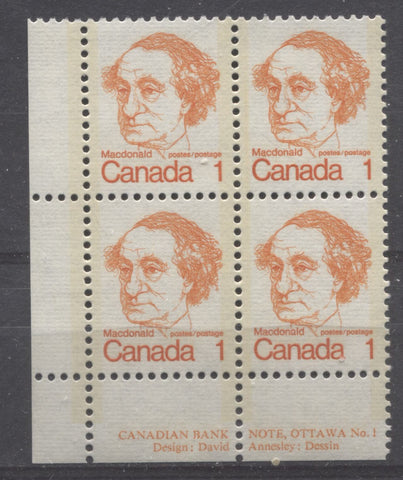
The above block is a typical plate block of one of the low value stamps printed by the CBN. As you can see the selvage was fully perforated through on both sides. However, this was based on a specific width for the selvage tabs. You can often find blocks in which the selvage is missing 1 or 2 perforation holes to be fully perforated through. If you measure the width of the selvage tabs for these blocks, you will invariably find that they are wider than usual, which is why the selvage is not perforated fully through. The pictures below show examples of blocks in which the top or bottom selvage is not quite perforated through, and others where it is the side selvage that is so affected:

Here you can see that the top selvage is almost perforated through, missing only 2 perforation holes.
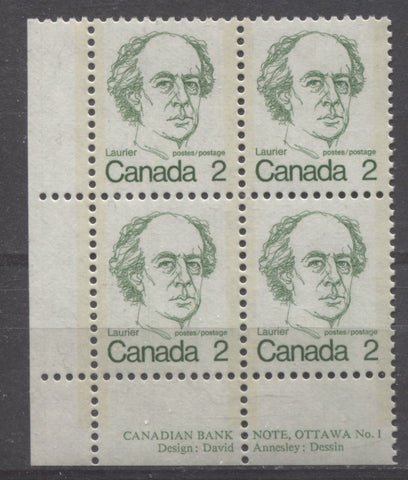
Here is an example of the lower left plate 1 block of the 2c Laurier which has left selvage that is perforated through except for the last perforation holes.
If you look carefully at these blocks you will see that the horizontal and vertical perforations are perfectly aligned, so that it appears as though the entire sheet is perforated with one single strike of the comb perforator. It is possible that some printings were perforated in this way, but what is far more likely is that 3 strikes of the perforator were required to perforate each sheet. If you look carefully at some sheets, you will see 2 spots where the vertical perforations do not quite line up: one near the top of the sheet and one near the bottom. This suggests three strikes were required and that the first and third strikes would have partially perforated the sheets above and below a sheet. The existence of side selvage that is not quite perforated all the way through suggests that the printing layout would have consisted of a rectangular or square arrangement of panes. The pictures below show two plate blocks that exhibit misalignment of perforations where one strike of the perforator ends and the other begins:
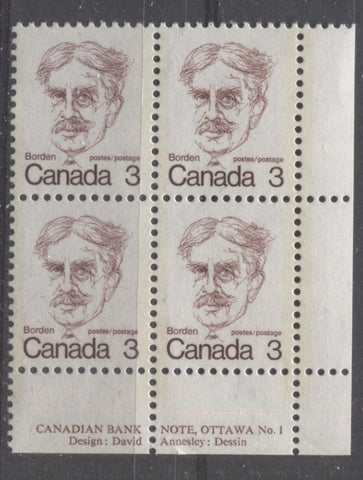
On this block look at the vertical perforations mid-way up the top stamps. You should be able to see a slight misalignment from where the bottom strike of the comb perforator ends and the top one begins.
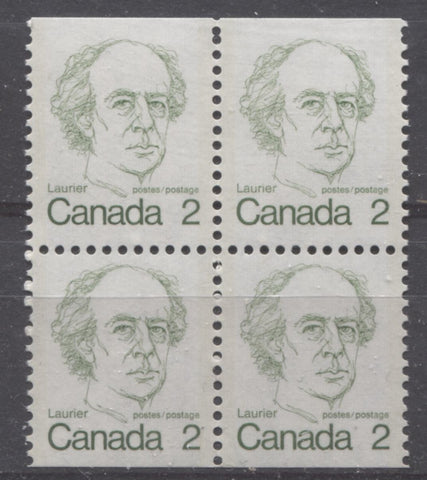
Here we can see a block of 4 stamps from a booklet pane. At the very top of the block you can see double punching of perforations, which indicates that there were two strikes of the comb perforator. In all likelihood, the panes were arranged in large sheets, but further study would be necessary to establish the exact layout of the booklet panes.
In addition to the problems that CBN experienced with alignment of the perforations there are also instances in which unusual shaped perforations can be found - most likely the result of double punching of the perforations. The scan below shows an unusual elliptical perforation that I found on the lower rows of a sheet of 1c Macdonald stamps:

Look at how sharp and narrow those perforations become half way down the stamp. The perforations have an elliptical shape, rather than being round.
The BABN printings of the 7c St. Laurent and 8c Queen had the top and bottom selvage of the sheets perforated through, while the side selvage is imperforate, except for one single extension hole, as shown below:
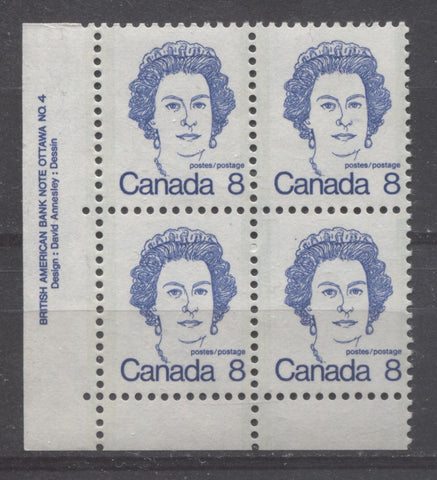
On this block, the alignment of the perforations is such that it appears to have been perforated by a single comb strike. Generally the sheets appear to have been perforated by a single comb strike on these stamps, but the comb only extended slightly into the top or bottom selvage of many blocks, and on many blocks you can see two distinct strikes of the comb perforator, as shown in the scans below:
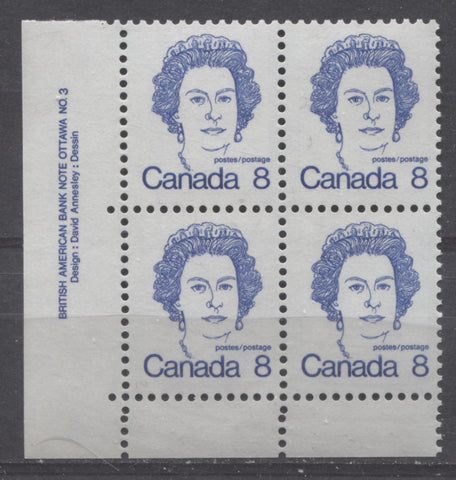
Here you can see two clear strikes of the comb perforator in the bottom selvage of the above block. This arrangement of perforation tends to suggest that the panes were arranged vertically in the print layout.
The 12.5 x 12 Comb Perforation
This perforation is found on the type 1 and first type 2 printings of the 10c through 50c values, as well as the first printings of the BABN printings of the $1 Vancouver. Generally on the 10c-$1 values, the side selvage is perforated through, while the top and bottom selvage shows only a single extension hole in the top or bottom selvage. This suggests a horizontal arrangement of the panes in the print arrangement.
On some blocks it is possible to see two comb strikes in the side selvage. The scans below show the typical appearance of these blocks:
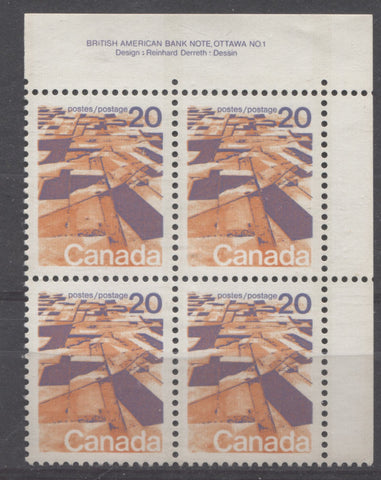
This block likely comes from the right hand end of the print run, as there are no double strikes of the comb perforator.
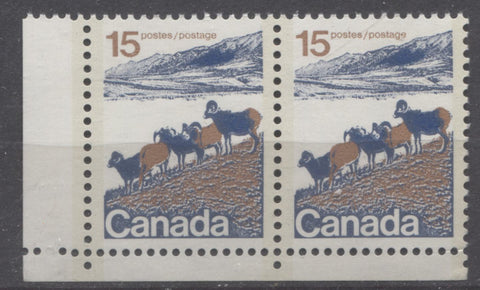
If you look carefully at the type 2 pair of the 15c mountain sheep shown above, you can see a slight mis-alignment of the horizontal perforations in the left selvage tab. This suggests that there were two comb strikes and that this comes from one of the middle panes in the print run.
The 13 x 13.3 Comb Perforation
This perforation is only found on two stamps, being the 10c Queen sheet stamps and the 8c Queen sheet stamps from plate 6. In all cases, the selvage is perforated through on all sides. However, double strikes of the perforator can often be seen at the top and bottom of selected blocks. This suggests a vertical arrangement of the panes in the print layout.
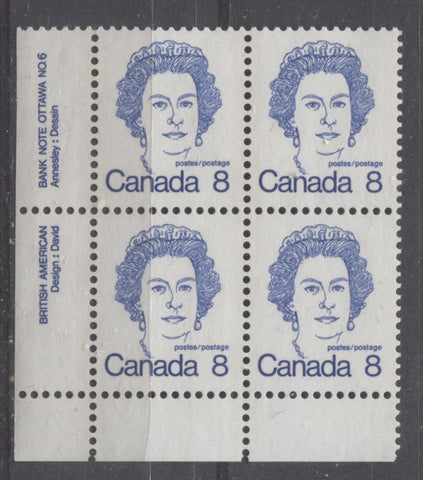
Here you can just make out a second comb strike at the very bottom of the block.

Here, you can see a similar double comb strike, this time at the top of the block.
The 10 Line Perforation
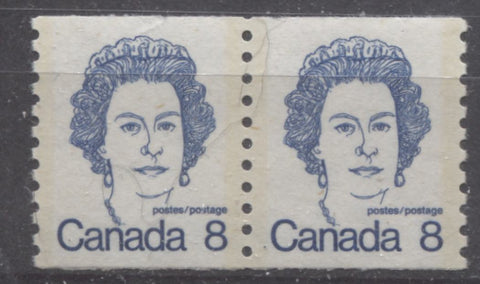
This perforation was used only for the coil stamps. These coils were produced in large sheets that were line perforated, rolled up and scored between the rolls. I am positing that this was a line perforation from the fact that the earlier Centennial coils used the same line perforation, and I have never seen any mis-alignment of the vertical perforations in a pair, or large block.
The 11 Line Perforation
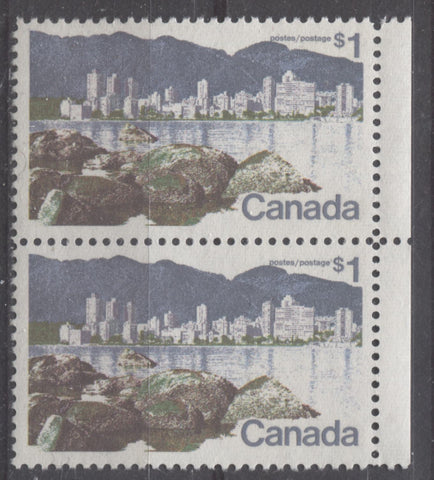
Given that this perforation is only found on other stamps printed by Ashton Potter, I am going to go ahead and guess that this is their perforation job, which explains why it is only found on the $1 and $2 values printed by them. You can clearly see in the above scan that it is indeed a line, rather than comb perforation. Also, the top and bottom and side selvage of all blocks is fully perforated through, as one would expect.
The 13.3 Comb Perforation

This perforation is only found on the last printings of the 10c-$1 values. Generally, the selvage of the sheets is fully perforated through, except for some printings of the 50c and all printings of the $1. On these, the side selvage is fully perforated and the upper and lower selvage shows only a single extension hole, suggesting a horizontal arrangement of the panes. On the other values, I have noticed double perforation strikes in the side margins, but never the top or bottom. Similarly, I have come across blocks that are not quite perforated through on the top or bottom, for the same reasons as the low values. Again, this suggests a horizontal arrangement of the panes in the print layout.
So there you have it. A seemingly simple topic which is actually more complicated than first appears. Next week I am going to look at the tagging found on these stamps.


3 comments
Merci beaucoup pour toutes ces informations concernant les perforations. J’apprécie énormément d’en apprendre et merci de partager vos connaissances à notre profit.
Denis
Hi Charles. Thank you so very much. I will be sure to check them out when I have time.
Best regards,
Chris
Hi Chris.
Thank you once again for providing such an interesting read on this fascinating topic.
I want to bring to your attention a couple of articles that I have had the pleasure to read lately.
You might have already read them, however, I would like to share them with you.
They are two articles by Leopold Beaudet from BNA Topics, Vol. 33, Nos. 5 and 6. You can access these articles from the Horace W. Harrison Library on the BNAPS website. They are called ’The 1973 Prime Minister Definitives. The first article in number 5, is about how the stamps were perforated. The second article in number 6, is a chronological study of the issue with a focus on paper fluorescense and tagging. They are both fascinating articles and have inspired me to revisit the issue and reorganize my collection according to the information contained within.
I am sure that you will enjoy these articles.
Thank you, once again.
Charles